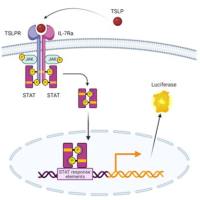LINE-1 Elements: Analysis by Fluorescence In-Situ Hybridization and Nucleotide Sequences
互联网
431
Long-interspersed nuclear element-1 (LINE-1) is a non-terminal repeat transposon that constitutes a major component of the mammalian genome. LINE-1 has a dynamic evolutionary history characterized by the rise, fall, and replacement of subfamilies. The distribution of LINE-1 elements can be viewed from a chromosomal perspective using fluorescence in-situ hybridization (FISH), as well as at the sequence level. We have designed LINE-1 primers from regions conserved among mouse, rat, rabbit, and human L1, which were able to amplify part of ORF2 from all eutherian (placental) mammals tested thus far. The product generated can be used as a FISH painting probe to examine the genomic distribution of L1 in different species. It can also be cloned and sequenced for phylogenetic analysis. Although FISH patterns resulting from LINE-1 chromosome painting and bioinformatic analyses have shown that this element accumulates in AT-rich regions of the genomes of mouse and human, our PCR amplified LINE-1 probe suggests that this is not a universal phenomenon, and that the patterns displayed in laurasiatherian, afrotherian and xenarthran species are less prominent. The “banding” like distribution of LINE-1 observed in human and mouse, therefore, appears to reflect aspects of genome architecture unique to Euarchontoglires (Supraprimates), the superordinal clade to which they belong.
By sequencing the cloned amplicons used for FISH experiments and supplementing these with L1 sequences obtained from public databases, analysis by parsimony, distance-based, maximum likelihood, and “hierarchical Bayesian” or “marginal likelihood” methods provides a powerful adjunct to the FISH data. Using this approach, relatively intact LINE-1 from most placental orders tend to reflect accepted eutherian evolutionary relationships. This suggests that there were often only closely related copies active near branch points in the tree, that inactive copies tended to become extinct quite readily, and that for many orders recently active copies belong to a single lineage of this LINE.








